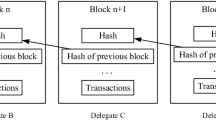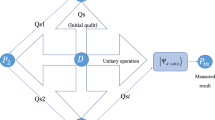Abstract
With the rise of the Internet plus blockchain, quantum secure communication has become a hot topic of interdisciplinary research. Secret sharing is the key technology to realize blockchain. In this paper, the Hermite interpolation polynomial combined with the idea of homomorphic cryptography is used to construct a multi-secret sharing model based on quantum graph theory. This paper relies on the theory of quantum theory to have mature theoretical and experimental foundations in quantum preparation, storage transmission, and measurement feasibility and overcomes the existing program feasibility problems and potential security problems with classical cryptography. This model is outsourced, verifiable, and extensible and has a high information rate. It can effectively resist external interception, replay, entanglement, tampering attacks and internal forgery, impersonation, deception, and collusion attacks. This paper has carried on a detailed analysis of the model.



Similar content being viewed by others
References
Karlin, S., Karon, J.M.: On hermite-birkhoff interpolation. J. Approx. Theory 16(3), 538–543 (1966)
Ctlin, D.C., Laurentiu, T.F.: On the asymptotic idealness of the asmuth-bloom threshold secret sharing scheme. Inform. Sci. 463-464, 75–85 (2018)
Bahramian, M., Sheikhi-Garjan, M., Doche, C.: A threshold verifiable multi-secret sharing based on elliptic curves and chinese remainder theorem. IET Inf. Secur. 13(3), 278–284 (2019)
Cafaro, M., Pelle, P.: Space-efficient verifiable secret sharing using polynomial interpolation. IEEE T. Cloud Comput. PP(99), 1–1 (2015)
Cao, W.-F., Yang, Y.-G.: Verifiable quantum secret sharing protocols based on four-qubit entangled states. Int. J. Theor. Phys. 58(4), 1202–1214 (2019)
Wang, N., Fu, J., Zeng, J.: Verifiable secret sharing scheme without dealer based on vector space access structures over bilinear groups. Electron. Lett. 54 (2), 77–79 (2018)
Imai, J., Mimura, M., Tanaka, H.: Verifiable secret sharing scheme using hash values. In: 2018 sixth international symposium on computing and networking workshops (CANDARW) (2018)
Zhang, E., Zhu, J.-Z., Li, G.-L., Chang, J., Li, Y.: Outsourcing hierarchical threshold secret sharing scheme based on reputation. Secur. Commun. Netw. 2019(10), 1–8 (2019)
Boyle, E., Kohl, l., Scholl, P.: Homomorphic Secret Sharing from Lattices Without FHE (2019)
Dawson, E., He, J.: Multisecret-sharing scheme based on one-way function. Electron. Lett. 31(2), 93–95 (2002)
Xiaoqin, T., Zhiguo, W.: Verifiable multi-secret sharing scheme based on hermite interpolation polynomial. Math. J. 29(3), 367–372 (2009)
Bennett, C., Brassard, G.: Quantum cryptography: public key distribution and coin tossing. In: Proceedings of IEE international conference on computers, systems and signal processing. Quantum cryptography: public key distribution and coin tossing, vol. 01, pp 175–179 (1984)
Dehkordi, M., Fattahi, E.: Threshold quantum secret sharing between multiparty and multiparty using greenberger-horne-zeilinger state. Quantum Inf. Process. 12(2), 1299–1306 (2013)
Yang, Y.G., Wen, Q.: Threshold quantum secret sharing between multi-party and multi-party. Sci. China 51(9), 1308–1315 (2008)
Long, G.L., Liu, X.S.: Theoretically efficient high-capacity quantum-key-distribution scheme. Phys. Rev. A 65(3), 032302.1–032302.3 (2002)
Semenenko, H., Sibson, P., Thompson, M.G., Erven, C.: Interference between independent photonic integrated devices for quantum key distribution. vol. 44, no. 2, pp.275 (2019)
Qin, H, Dai, Y.: An efficient (t,n) threshold quantum secret sharing without entanglement. Mod. Phys. Lett. B 30(12), 1650138 (2016)
Deng, F.G., Yan, F.L., Li, X.H., Li, C.Y., Zhou, H.Y., Gao, T.: Addendum to quantum secret sharing between multiparty and multiparty without entanglement. Phys. Rev. A, vol. 72, no. 1, pp. – (2005)
Hillery, M., Buzek, V., Berthiaume, A.: Quantum secret sharing. Phys. Rev. A (1999)
Du, Y.-T., Bao, W.-S.: Dynamic quantum secret sharing protocol based on two-particle transform of bell states. Chinese Phys. B 27(08), 122–127 (2018)
Ko, W.T., Chiou, S.Y., Lu, E.H., Chang, K.C.: Modifying the ecc-based grouping-proof rfid system to increase inpatient medication safety. J. Med. Syst. 38(9), 1–12 (2014)
Qin, H., Zhu, X., Dai, Y.: (t,n) Threshold quantum secret sharing using the phase shift operation. Quantum Inf. Process. 14(8), 2997–3004 (2015)
Wang, Q., Shi, R.-H., Chen, Z.-K., Wang, S.-L.: A quantum sealed auction protocol based on secret sharing. Int. J. Theor. Phys. 4, 1–10 (2019)
Wang, X.-B.: Beating the photon-number-splitting attack in practical quantum cryptography. Phys. Rev. Lett. 94(23), 230503 (2005)
Gottesman, D.: Theory of quantum secret sharing. Phys. Rev. A 61(4), 192–193 (2000)
Bell, B., Herrera-Martí, D., Tame, M., Markham, D., Wadsworth, W., Rarity, J.: Experimental demonstration of a graph state quantum error-correction code. Nat. Commun. 5(4), 3658 (2014)
Bell, B., Markham, D., Herrera-Martí, D., Marin, A., Wadsworth, W., Rarity, J., Tame, M.: Experimental demonstration of graph-state quantum secret sharing. Nat. Commun. 5, 5480 (2014)
Markham, D., Krause, A.: A simple protocol for certifying graph states and applications in quantum networks (2018)
Jian-Wu, L., Xiao-Shu, L., Jin-Jing, S., Ying, G.: Multiparty quantum blind signature scheme based on graph states. Int. J. Theor. Phys. 57(8), 2404–2414 (2018)
Jian-Wu, L., Xiao-Shu, L., Chenzi: Quantum secret sharing scheme based on graph state and chinese remainder theorem. J. Commun. 39(10), 76–82 (2018)
Lu, C.Y., Zhou, X.-Q., Güne, O., Gao, W.-B., Zhang, J., Yuan, Z.-S., Goebel, A., Yang, T., Pan, J.-W.: Experimental entanglement of six photons in graph states. Nat. Phys. 3(2), 255 (2007)
Schlingemann, D., Werner, R.F.: Quantum error-correcting codes associated with graphs. Phys. Rev. A quant-ph/0012111, 337–339 (2000)
Yagisawa, M.: Fully homomorphic encryption without bootstrapping. Acm Transactions on Computation Theory 6(3), 1–36 (2015)
Jian, X., Wei, L., Yu, Z., Wang, A., Gao, C.Z.: Dynamic fully homomorphic encryption-based merkle tree for lightweight streaming authenticated data structures. J. Netw. Comput. Appl. 107, 113–124 (2018)
Hein, M., Eisert, J., Briegel, H.J.: Multi-party entanglement in graph states. Phys. Rev. A 69(6), 666–670 (2003)
Fortescue, B., Markham, D., Sanders, B.C.: Graph state secret sharing in higher-dimensional systems. In: Proceedings of SPIE - the international society for optical engineering, vol. 7815, pp 78150T–78150T–7 (2010)
Keet, A., Fortescue, B., Markham, D., Sanders, B.C.: Quantum secret sharing with qudit graph states. Phys. Rev. A 82(6), 4229–4231 (2010)
Biham, E., Mor, T.: Security of quantum cryptography against collective attacks. Phys. Rev. Lett. 78(11), 2256–2259 (1997)
Bartlett, S.D., de Guise, H., Sanders, B.C.: Quantum encodings in spin systems and harmonic oscillators. Phys. Rev. A 65(5), 882–886 (2002)
Glynn, D.: On self-dual quantum codes and graphs. 07 (2019)
Brádler, K., Dusek, M.: Secret-message sharing via direct transmission. J. Opt. B: Quantum Semiclass. Opt. 6(1), 63–68 (2003)
Shang, X.J., Wei-Zhang, D.U.: Publicly verifiable multi-secret sharing scheme based on bilinear pairings. Comput. Eng. (2014)
Zhang, E., Peng, J., Li, M.: Outsourcing secret sharing scheme based on homomorphism encryption. IET Inf. Secur. 12(1), 94–99 (2018)
Lin, C., Hu, H., Chang, C.C., Tang, S.: A publicly verifiable multi-secret sharing scheme with outsourcing secret reconstruction. IEEE Access
Author information
Authors and Affiliations
Corresponding author
Additional information
Publisher’s Note
Springer Nature remains neutral with regard to jurisdictional claims in published maps and institutional affiliations.
Electronic supplementary material
Below is the link to the electronic supplementary material.
Rights and permissions
About this article
Cite this article
Zhou, Q., Lv, H. Multi-secret Sharing Model based on Hermite Interpolation Polynomial and Quantum Graph State. Int J Theor Phys 59, 2271–2293 (2020). https://doi.org/10.1007/s10773-020-04494-1
Received:
Accepted:
Published:
Issue Date:
DOI: https://doi.org/10.1007/s10773-020-04494-1




